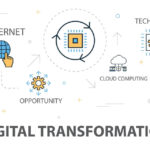A growing number of organizations across industry verticals are adopting Digital Transformation (DX) to remain relevant and competitive by matching customer, market and industry changes. It supports in automating and infusing intelligence across organizational functions – be it operations, HR, Finance or Sales and Marketing.
However, according to Global McKinsey survey results, only less than 30% of DX processes have been successful! This clearly indicates that the strategy, tools or implementation of the process could be flawed, unfavorably impacting time, finance and resources.
To ensure the organization’s DX efforts are successful in bringing better performance and delivering higher value to customers, implementing best practices is the key.
Engage Employees while Managing the Change
As organization opt to go on the DX journey, one of the important factors to be considered is to re-imagine the workforce engagement. At the outset, employees should be made aware of the changes – the objectives, benefits of going digital and the impacts of not going digital. This effort of bringing about the change from a traditional mindset to adopting a digital mindset is certainly a cultural one and will empower employees to perform better. Employees should be trained and equipped with new skill sets to ensure the necessary investments in DX do not go in vain.
Customer-first approach will lead to success
One of the primary goals of DX is to deliver better customer experience. Hence mapping the journey of customers by leveraging data analytics will provide insights on their preferences, buying patterns and evolving needs. Catering to customer’s new requirements with appropriate product recommendations and customized offerings can increase the number of repeat customers. The apps and various digital channels for customer interactions should be user-friendly with all necessary information. This content should be consistent across all touch-points for the multichannel customer of today.
Establish Good Rapport between Technology & Business Leaders
Gone are the days where business and technology worked in silos. Today, one cannot exist without the other. Furthermore, DX is a business decision for the entire organization with the involvement of different business unit leaders and stakeholders. The CIO has to move from his role of being a functional head to becoming a strategic business leader whereas the business unit head has to understand and work with digital technologies, thereby making it all the more crucial for both the leaders to work in tandem. Together they can roll-out digital products for new market needs and drive better business outcomes.
Cyber Security Strategy should be in Place
Data is the new gold and requires to be safeguarded as this can be converted to insights for better operational excellence, customer service and revenues.However, data breaches are on the rise and are becoming roadblocks for technological innovations in addition to triggering financial losses and brand damage. By developing and deploying a robust cyber-security program, businesses can become less vulnerable to cyber threats. Investments in the right technology and expertise to protect business assets should be done with a complete understanding of the threat landscape and should be integrated into the DX process at the very beginning to be made effective.
Digital Transformation is an operational, organizational and cultural change and measuring its success should be an ongoing effort. A holistic approach, beyond disintegrated technologies, tools and processes should be followed, with active role played by all stakeholders.




